A Closer Look
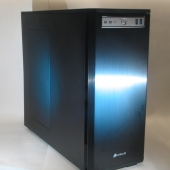 |
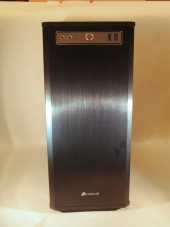 |
As has been the trend with the Obsidian series, this case presents an impassive front with little ornamentation. Aside from the Corsair badge at center bottom, the brushed aluminum front panel is broken only by a single panel near the top. The central power button and HDD activity light are flanked by headset and microphone jacks on the left, as well as a flush-fit reset button. To the right are the only front I/O ports, two USB 3.0. These are spread out a bit, which helps for accommodating bulky flash drives.
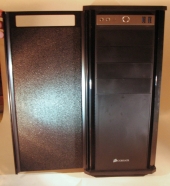 |
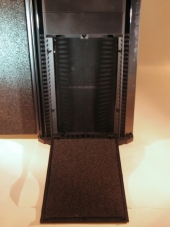 |
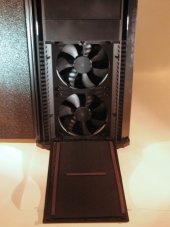 |
The door, which holds itself shut with spring clips at top and bottom, opens up to an angle of 180°. Interestingly, these clips are present on both sides of the door, allowing it to swing open to either side, or to come off completely. The inside of the door is covered in a thin sheet of acoustic foam, which helps to eliminate any rattling that might otherwise occur. Below the I/O ports, there are four 5.25″ bays, with covers in place. No external 3.5″ bays are present, which is a bit unfortunate.
Below the drive bays is a plastic panel that comes off with a press on the latch point at its top. Beneath this we see a mesh filter guarding a pair of 120mm intake fans. In a particularly clever move, Corsair has designed this filter to attach to the frame with thin strip magnets glued on at the edges. This allows the filter to be as thin as possible without compromising coverage, and also facilitates easy cleaning. The fans themselves are plain black, no lights or ornamentation.
 |
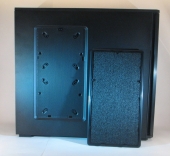 |
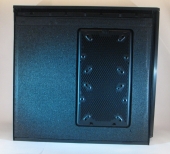 |
The left side cover panel is similarly stark, with only a single pop-off panel to mar the surface. Beneath this panel is yet more acoustic foam, and rubber grommeted mount points for two 120mm or 140mm fans. On the panel’s backside is yet more acoustic foam.
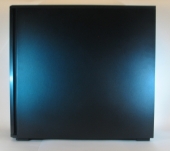 |
 |
As you might expect, the right side cover panel is completely blank. Once again, the inside is covered top to bottom with acoustic foam.
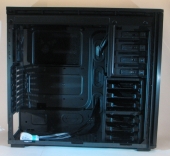 |
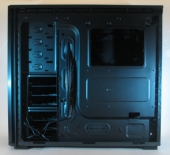 |
The all-black theme continues on the inside, with all surfaces being either black plastic or black-painted steel. In a nice bit of attention to detail, the front panel header cables and fan power cables are also solid black, keeping them from standing out.
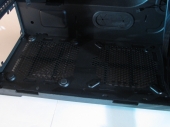 |
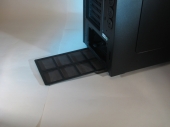 |
As is fairly common these days, the power supply mount is at the bottom rear of the case, with an intake port situated to allow the PSU to draw in air from outside the case. In front of that is another of the case’s fan mount-points, with mounting holes for 120mm and 140mm fans. Both intake ports are covered by a mesh dust filter, which pulls out from the bottom rear of the case for cleaning.
 |
The area near the rear of the motherboard has several interesting features. The expansion slot covers are perforated, to allow for better airflow, and held in place with thumbscrews in the ubiquitous black. Right next to this are four grommeted ports for water cooling tubes. Immediately above is an exhaust fan port, with an included 120mm fan. Like the others, this port can accommodate a 140mm fan instead if you wish.
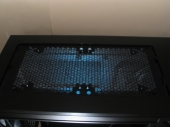 |
 |
The top of the case has a couple of the dual-size fan ports hidden behind a pop-off panel. Their position in a recess above the motherboard tray makes them ideal for a dual 120mm or dual 140mm radiator, if you’re going the liquid-cooling route.
 |
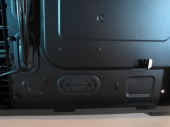 |
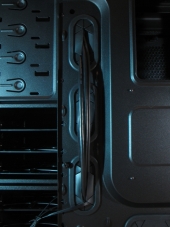 |
One area where this case stands out is in its attention to cable management. The areas below and to the front of the motherboard mounting area are not only accessed through oversized, rubber grommeted holes, but are raised up a half inch or so to allow extra room for cables to be run back there, where they’ll be out of the way.
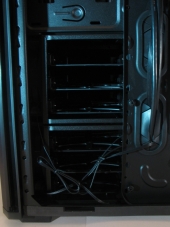 |
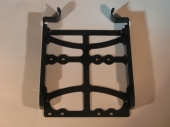 |
Moving forward, the 3.5″ drive cage is another area worth mentioning. Each of the two drive cages holds three drives each, and can be removed independently after unscrewing a few thumbscrews. These screws were torqued a bit tight in our review model, but a few turns with a Phillips-head screwdriver loosened them to the point where thumb and forefinger could do the rest.
Refreshingly, Corsair has opted to resist the urge to cram the cages full with as many drives as possible. Instead, each drive has airflow space above and below it, with intake fans positioned just in front of the cages. So if you must have six hard drives in your rig, you can rest assured they won’t die prematurely to overheating.
The drive brackets are also worth something of a mention; they can quickly accommodate any 3.5″ drive with no tools, and can also mount 2.5″ drives with a few screws in the bottom.


[…] Corsair Obsidian 550D Mid-tower Case Review @ TechwareLabs […]
[…] Armor Revo Case @ eTeknix AZZA Genesis 9000 Case @ Legit Reviews Corsair Obsidian 550D Case @TechwareLabs Cooler Master Elite 120 Case @ Cowcotland Cooler Master Silencio 650 Case @Cowcotland Lian Li […]
[…] Genesis 9000 Case @ Legit ReviewsCorsair Obsidian 550D Case @ TechwareLabsCooler Master Elite 120 Case @ CowcotlandCooler Master Silencio 650 Case @ CowcotlandLian Li […]
[…] Corsair Obsidian 550D Mid-tower Case Review @ TechwareLabs […]
[…] Corsair Obsidian 550D Mid-tower Case Review @ TechwareLabs […]
[…] Corsair Obsidian 550D Mid-tower Case Review @ TechwareLabs […]